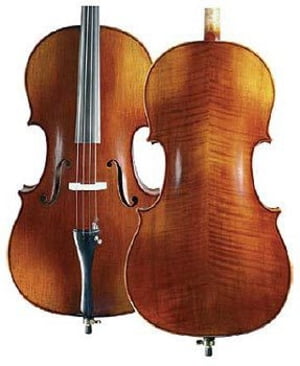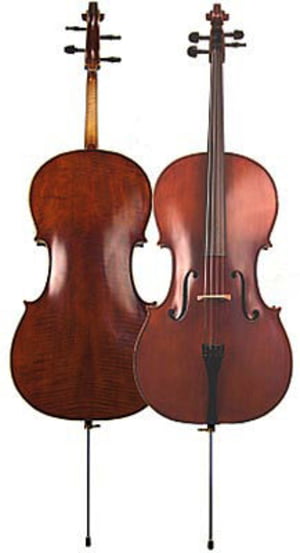2. History & Design
The cello belongs to the string, or violin family, a group of four closely related instruments - the violin, the viola, the cello (short for violoncello, hence the apostrophe) and the double bass (often simply referred to as the bass). It is tuned exactly an octave (eight notes) below the viola and, in common with both the violin and the viola, has each of its four strings a fifth (five notes) apart. Of all the stringed instruments, it is probably the cello that has the strongest fascination for people of all ages. While not so obviously cumbersome as a bass, it is startlingly large the shape that started life as the violin becomes boldly elegant when expanded to this size. It also appears appealingly fragile, though in fact, the joinery of all string instruments is rather stronger than looks would suggest.

A cello made of beautifully figured timber
Historically, it is the violin that has always been seen as the thoroughbred in the string instrument stable, with a glamorous and extensive repertoire to match. However, while the cello has not enjoyed quite the same prestige, the six, legendary solo suites by Bach, written in the first half of the 18th Century, started a trend that ensured it always had a role beyond merely playing bass lines. Composers like Vivaldi were also quick to realise it was capable of rather more than grumbling away at the bottom of the orchestra. Certainly the 19th Century saw a rapid growth in the number of major works written for the cello and the early years of the 20th Century produced the most famous of all the exquisitely melancholy and rhapsodic concerto by Edward Elgar. In many ways the cello is probably the most versatile instrument in the whole string family, with an effective bass range, but also an upper register that covers much of the low to middle range of the violin.
By comparison with most other instruments, all members of the string family are relatively simple, and on the face of it, low tech. However, as any string instrument maker will tell you, in place of the relatively high level of engineering that goes into producing many wind instruments, the construction of violins, violas and cellos requires a more intuitive, organic response to the materials. Learning to make instruments, like learning to play them, is a lifetimes work. Many string players find it fascinating to talk to violin or bow makers about the arcane blend of art and science that goes into creating an instrument - string instrument manufacturers are usually known as violin makers, though they will invariably make all types of string instruments.

When put side by side with much of the rest of the orchestra, the appearance of stringed instruments seems highly decorative, even fanciful. The eyes are drawn immediately to the extravagant detailing of the scroll, the f-holes and the ogee curve of the corners. Nonetheless, while the cello is undoubtedly a beautiful object, most of the design is essentially practical, and the result of an immensely long, multicultural gestation that spans the globe and traces its way back through a millennium.




